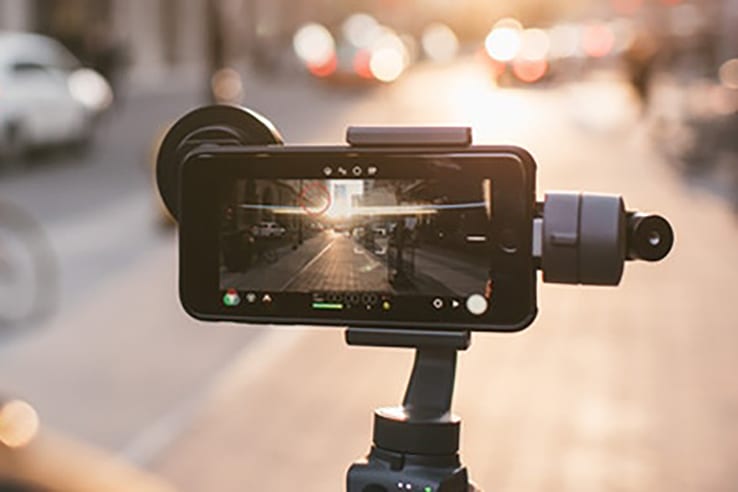CAPTION: WATCH AND SHOOT: With the latest smart phone from Apple you can not only watch popular and classical movies, you can even shoot your own profesional quality films!
By Larreola
Very soon even posh multiplexes may be a thing of the past as you will be able to watch brand new films through devices that give you a theatre-like experience in the comfort of your home. To retain viewers, cinemas must use the latest innovative technology
The cinema industry has already experienced significant impact as a result of the internet. The industry is still adapting and finding that even for the conveniences offered by internet-enabled movie viewing, many movie-goers still migrate back to the big, wide movie screens offered by the cinema experience. Providing an exceptional user experience during their time in-cinema through equipment availability, enabling consistent sound and projection experiences can positively enhance bottom-line revenue.
Cinema operators are finding unexpected benefits including operational and functional improvements using the ‘internet of things’ or IoT platform. The IoT can streamline the way exhibitors operate their movie theaters by providing a seamless connection to facilitate remote monitoring, control, automation, and analytics between uniquely identified devices and their users.
How IoT Works
IoT is the concept of seamless connections to facilitate smart coordination between devices and their users. It entails a network of ‘People’, ‘Data’, and ‘Processes’ allowing ‘Things’ such as cinema equipment to be sensed and controlled remotely across existing network infrastructures.
Nearly all types of media and entertainment businesses will benefit from the IoT, and the future of the cinema industry can be better understood with a closer evaluation of the ‘Internet of Things’.
What are IoT things?
Things are defined as physical equipment and objects connected to the internet by a web-enabled device, sometimes retrofitted, or installed at the original equipment manufacturers’ (OEM) facility. The IoT device produces data from the equipment using sensors and sends it through the network to processors and communication hardware. The data measured can include nearly anything but will usually include: operating temperatures, equipment run-time, or the number of times the equipment is operated in a given time frame.
This depth of data and analytics available can allow a cinema operator to make intelligent, data-driven decisions. The integration of IoT results in improved efficiency, accuracy, and economic benefit through a reduction in unnecessary human intervention for things like preventive maintenance, environmental temperatures, and replacement parts among other things.
How IoT Affects The Cinema industry
The need to lower motion pictures distribution costs while increasing higher picture and sound quality were the primary catalysts for the Cinema Industry’s digital transition, enabling exhibitors to adopt innovations of the time that we all see as normal today. For example, TMS playlist creation, satellite distribution, and email KDM delivery led the way, but were merely the “tip of the iceberg” of vast capabilities available to cinema operators.
Many viewed digitization as a one-time innovation that dramatically changed the cinema industry, as though future innovations would not be so wide-spread or impactful. But in fact, it was just the beginning.
Now, everything is connected to a network and the internet. We can gather and analyze data previously unavailable and can include equipment operational behavior and the humans operating them.
What we’ll see, going forward, will be internet-connected devices enabling better schedule-streamlining, content-playing, process automation, and asset analytics. The cinema industry has been slow to adopt IoT, waiting for better integration of the various digital cinema devices. Early adopters have already begun to realize the full benefits of IoT and leverage the data produced, creating a competitive advantage in their respective markets.
In 2015 CE+S, a cinema industry pioneer, revolutionised the cinema industry with the launch of CIELO, a first-of-its-kind, cloud-based, remote monitoring, and analytics platform developed specifically for the IoT-era providing visibility, data processing, and control of digital cinema equipment.
the future of the Cinema Industry
We know that the current list of capabilities will expand to Enterprise TMS for centralized content management, broadband content distribution, and programmatic content scheduling. You can be certain that with all the data available you’ll see automatic just-in-time (JIT) parts and consumables fulfillment, and predictive self-healing maintenance.
This kind of maintenance of projection equipment, as already in use today, is benefiting the area of consumables. For example, while we already know roughly the useful life of a Xenon lamp, by introducing an algorithm accounting for the average lamp consumption, the machinery can then calculate of its own accord exactly when that lamp will need replacing. The automation of a triggered notification to inventory and maintenance or the supplier will ensure that the part will be sent before the lamp fails and can be replaced in plenty of time so that moviegoers won’t show up to a potentially canceled show.
From the support services perspective, having visibility of the entire network along with the predictability of aggregated data analytics for the equipment allows technicians to be scheduled efficiently to perform preventive maintenance activities or remotely solve a higher number of cases before they become a major issue. This proactive maintenance plan will alleviate and dramatically decrease emergency maintenance call costs with the potential to save money in lost revenues as well.
In cases where an unscheduled or unplanned equipment outage happens, knowing exactly which part is required for replacement can greatly optimize efficiency. Using the data provided by the IoT system can reduce technician on-site resolution time and overall tech support and logistics costs.
Through the use of IoT in the cinema industry, the transformation is happening, and it is enabling higher levels of maintainability for equipment owners and improved equipment uptime so that they can meet their customer’s expectations reliably. IoT is enabling cinema owners peace of mind, knowing their equipment and assets can deliver on the content they’ve promoted. Now, they can focus on other aspects of creating an exceptional customer experience.
Courtesy: CE+S
